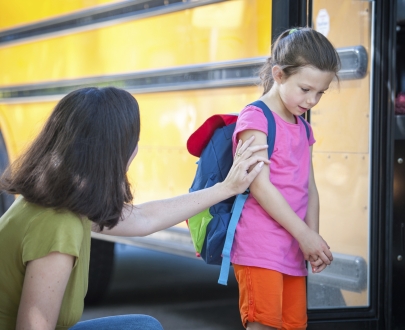 We all need some anxiety, or we’d be dead!
We all need some anxiety, or we’d be dead!
Anxiety[1] is an essential emotion, one that helps to keep us alert, cautious and safe. For example,it is normal and healthy to experience anxiety when we are approached by a growling dog. And anxiety can also be a motivator when we need to prepare for an exam or a performance. But when anxiety becomes chronic, persistent and begins to interfere with everyday life, this “helpful emotion” tips the scale towards a mental health disorder.
Normal anxieties[2] happen at every stage of development. Anxiety disorders, on the other hand, typically begin during one of three childhood transitions; starting school for the first time, grade 4 when the curriculum becomes more challenging, and during puberty. Anxiety disorders have a good news - bad news story. The good news is that it is the most treatable of mental health problems with the best treatment being ‘talk’ therapy - specifically Cognitive Behavioural Therapy[3]. The bad news is that anxiety is often misdiagnosed and without treatment, anxiety doesn’t go away.
While anxiety symptoms are very individual, if you see persistent and excessive worrying and/or physical signs such as muscle tension, stomach aches, sleep problems, irritability or trouble going to school, anxiety might be the cause.
If you or someone you love experiences anxiety (from uncomfortable to debilitating), practice these simple, free, effective skills to tame the worry.
Calm Breathing
There are both physical and psychological benefits[4] that come from deep, calm breaths. Simply, inhale for a count of two, exhale for a count of two, pause for a count of two. Repeat! Experiment with a variety of calm breathing techniques[5] also known as diaphragmatic or belly breathing (try using bubbles, stuffed animals and feathers!)
Progressive Relaxation
This technique involves tensing and then relaxing different muscles in the body in sequence. It helps a child gain more control over his or her body and learn the difference between what it feels like to be tense and relaxed. Additionally, progressive relaxation has been shown to reduce the physical symptoms of anxiety and improve sleep. Try following a script[6] to help guide a child through the process.
Visual Imagery
Particularly helpful with social anxiety, this technique helps children to change how they see the outcome in a situation that they are worrying about. Visualization can calm their emotions and help them feel more confident. Anxiety BC for Youth[7] has a series of visualization audios and scripts that can shape thinking to be more positive.
Learning more is the best first step for anyone struggling with anxiety.
Anxiety BC defines anxiety as a normal emotion that is essential for survival.
Most people consider anxiety to be a problem when it causes significant distress or interference for the child or the family.
Very common, normal anxieties and fears that occur during development include:
infants - separation, new things
preschoolers - animals, dark, separation
school-aged children - performance, family issues
pre-adolescents - mortality, health
adolescents - social, existential, future
Cognitive Behaviour Therapy (CBT) focuses on the way people think ("cognitive") and act ("behaviour").
Our thoughts about a situation affect how we feel (emotionally and physically) and how we behave in that situation. CBT helps to find out how you can interrupt a negative cycle of thoughts and behaviours.
Research has shown that CBT is one of the most effective treatments for anxiety.
A study comparing respiratory stability (breathing and oxygen intake) when someone was worrying compared to when they were being mindful found that during worry, breathing was less stable. They also found that mindfulness has a stabilizing effect.
Breathing helps the brain! There are both physical and psychological benefits from deep, calm breaths. They slow your heart rate, lower your blood pressure and even sharpen your focus.
Check out this link for ideas to introduce and practice breathing with children.
Learn to pay attention to body clues. Progressive relaxation teaches a process of tensing and then relaxing muscles systematically.
Try this child-friendly script from the Friends for Life Parent Program.
Anxiety BC, Anxiety BC YOUTH and Friends for Life offer information uniquely tailored to parents, youth and young children.
Anxiety BC works to increase awareness about anxiety disorders; promote education; and increase access to evidence-based resources and treatments. They have a wide range of information and tools including videos, visualization scripts, a mobile app, and interactive websites.
BC Friends for Life Parenting Program has information, tools and video support for parents of children ages 4-7 and 9-13.